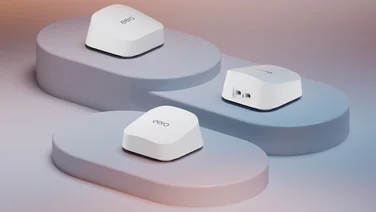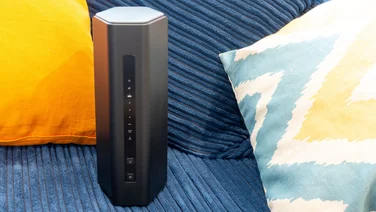To help us provide you with free impartial advice, we may earn a commission if you buy through links on our site. Learn more




If you don’t have a rack cabinet but still need masses of shared storage, high capacity free-standing NAS devices have obvious appeal. The Thecus TopTower N6850 is a powerful and competitively priced six-bay NAS enclosure with a dual-core 2.6GHz Intel Pentium G620 processor and 2GB of DDR3 RAM. Unlike most NAS devices, the N6850 is upgradeable, having two PCI-E slots that can be used to install expansion cards, such as ultra-fast 10GbE networking cards.

The N6850 has two USB2, two USB3 and one eSATA port on its back-panel, alongside a serial connection port and two LAN ports. It also has a HDMI port, and if you attach a keyboard and mouse you can control the NAS directly rather than access it via its web interface. It has another two USB2 and two USB3 ports at the front of the device and an LCD status screen with touch buttons.
Fitting our hard disks was simple. Small strips of rubber on the drive trays provide a degree of vibration damping, but we were surprised by the relatively loose fit of our drives within the trays. Unfortunately, the NAS is rather noisy in operation. Disk access sounds could be heard and the fans are surprisingly loud, which isn’t ideal for a NAS that might be kept in a main office.

The web interface could be a little confusing for anyone who’s not set up a NAS before, especially because of the poor quality of the GUI’s in-line help. Fortunately, getting the N6850 up and running is a simple process. All you have to do is click the Storage tab and then the RAID management icon in the tree that opens below it. Create your RAID array and you’re ready to go. The N6850’s RAID options are 0, 1, 5, 6, 10, 50 and JBOD.
We tested the NAS using six 4TB Western Digital RE enterprise drives, and ran tests in multiple RAID configurations, including RAID5, RAID10 and RAID50. We tested input and output speed on each type of array configured as both SMB shared folders and iSCSI targets.
In our array of six 4TB drives, RAID5 provides the greatest capacity (18,617.5GB) and the fastest speeds, averaging a throughput of 11.7MB/s in our large-file SMB test, 21.6MB/s in a small-file SMB test, and averaging 114MB/s and 37.3MB/s respectively in our large and small file iSCSI tests. However, RAID5 is less fault-tolerant than RAID10 or RAID50. It can only afford to lose one drive from the array, while both RAID50 and RAID10 can lose up to one disk from each sub-array, which means a loss of up to two disks could be sustained, depending on which disks fail.

RAID10 gives you just 11,171GB across six disks and produced slightly slower throughput in our SMB tests, with large- and small-file average of 94.9MB/s and 21.5MB/s. Our iSCSI tests produced a large average of 103.7MB/s and a small average throughput of 51.2MB/s – the fastest we saw in any of our tests on this NAS. RAID50 is the sweet spot between redundancy, throughput and capacity. You get 14,894GB of storage and SMB average throughputs of 100MB/s for large and 22.2MB/s for small files. iSCSI throughputs average 112.6MB/s and 41.22MB/s.
Once you’ve selected your RAID type, you’ll also be given the option of encrypting your volume. The N6850 has enough power to do this without a significant impact on performance, but it’s only worth doing if the NAS is going to be storing highly sensitive data. You can also set the volume you’re creating as the Master RAID array – this is only relevant if you plan on having more than one RAID volume in the NAS. A Quick RAID option means you won’t have to wait ages while the NAS carries out a low level scan and initialisation of the drives, although this is only intended for use with brand new disks.
The interface uses a tabular tree-structure menu in the right-hand pane presents the N6850’s features in a reasonably comprehensible manner. The Home screen presents you with icons that lead to the most commonly required settings and info screens, including an FTP server, the Share Folders (via SMB) settings, RAID management, iSCSI targeting and scheduling for periods during which the NAS should power itself off.
Storage Settings let you view and configure your RAID arrays, iSCSI targets and SMB shared folders. You’ll also find Thecus’s NAS stacking settings here – this option allows you to join together multiple NAS devices configured as iSCSI targets to provide up to 84TB of storage that behaves as a single disk. Below, the NAS’s User and Group Authentication settings are fairly standard, allowing you assign different permissions and quotas to users. You can also mount up to 100 ISO images as virtual discs and make them available across the network.

There’s plenty here, but it’s not as easy to get to grips with as some interfaces
While the backup components aren’t very well described within the GUI, the backup services include one of the few fully fledged wizards on the device. Perversely, this is only triggered when you select the Amazon S3 option. The wizard lets you configure the N6850 to back up to a remotely located NAS device, back itself up to a local device or vice versa or backup to your Amazon S3 cloud storage.
Plenty of modular software components are available from Thecus’s download centre, while others are developed by the user community. Official modules allow you to use the NAS as a webserver, including MySQL, as well as more media orientated services such as image gallery software, a TwonkyMedia DLNA server and both BitTorrent and NZB download clients. There are also several more conventionally business orientated modules, including mail servers, RAID replication, backup schedulers and support for cloud-based storage services such as DropBox. Mobile apps are also available to control, upload and access content on your NAS via Android or iOS.
Unfortunately, both the installation interface and the interfaces of the modules themselves tend to feel sketchy and poorly documented. Everything works as it’s supposed to but, like almost every other elements of the NAS’s interface, modules are inadequately described in broken English. It’s a long way from the glossy interfaces of rivals such as Synology and QNAP.
A key selling point of Thecus’s recent NAS devices is their ability to connect to a keyboard, mouse and HDMI display. Once again, poor documentation makes this far more difficult than it should be. By default, you get command line Linux access, which might be all that’s needed by some sysadmins. However, if you want to use Thecus’s direct multimedia features, you’ll have to spend a while dredging through support forum posts and painfully slow module downloads from Thecus’s website.
Once you have it installed, the Thecus LocalDisplay module is rather neat. It’s a lightweight window manager with large, friendly shortcut icons to launch Firefox and a command line terminal. However, if you want to add a media player or TV tuning app, you still have to download a third-party package distributed by Thecus’s forums. Although the N6850 has enough processor power and memory to play music and movies smoothly, we’re not convinced that anyone’s really going to want to use their business NAS as a clumsy alternative to a cheap HTPC. The LocalDisplay module is useful for administration, though.
The TopTower N6850 is fast, powerful and reasonably priced for a six-bay NAS enclosure, but we weren’t happy with the amount of noise it makes, the confusing and poor use of English in its web interface or the emphasis on user-created modules rather than officially authorised apps to add functionality. As it is, this NAS is a cost-effective option for businesses that need vast amounts of storage, but we can’t recommend wholeheartedly.





